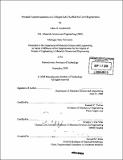| dc.contributor.advisor | Ioannis V. Yannas. | en_US |
| dc.contributor.author | Southworth, Adam R | en_US |
| dc.contributor.other | Massachusetts Institute of Technology. Dept. of Materials Science and Engineering. | en_US |
| dc.date.accessioned | 2009-04-29T17:29:42Z | |
| dc.date.available | 2009-04-29T17:29:42Z | |
| dc.date.copyright | 2008 | en_US |
| dc.date.issued | 2008 | en_US |
| dc.identifier.uri | http://hdl.handle.net/1721.1/45354 | |
| dc.description | Thesis (M. Eng.)--Massachusetts Institute of Technology, Dept. of Materials Science and Engineering, 2008. | en_US |
| dc.description | Includes bibliographical references (p. 63-65). | en_US |
| dc.description.abstract | The potential for commercializing a scaffold made of collagen and glycosaminoglycan to help regenerate cirrhotic liver was analyzed and a business plan and model were created. Using a lypholization technique, a bulk-sized and highly porous scaffold is created. It is then inserted into the hole created by the excised liver scar tissue. By blocking contraction of the wound and mimicking the natural extracellular matrix, the scaffold induces regeneration of normal liver tissue. The in vivo approach is compared to several other experimental treatments of cirrhosis found in the literature. The difficulties that need to be addressed are explained and potential solutions are given. A cost model was created, incorporating equipment, labor, FDA, and raw material costs. This model was combined with information regarding the cost of current liver transplant procedures to create a profitable business plan based on the collagen-GAG scaffolds. A manufacturing and product sales business model was chosen due to the fairly low level of market competition and moderate barrier to entry. The intellectual property landscape is described and analyzed in terms of problematic existing patents and the potential for protecting the proposed scaffolds. A timeline for future research and development was created, with potential sources of funding during each phase. In addition to the current embodiment of the scaffold, possible changes to the scaffold properties and composition are proposed. | en_US |
| dc.description.statementofresponsibility | by Adam R. Southworth. | en_US |
| dc.format.extent | 65 p. | en_US |
| dc.language.iso | eng | en_US |
| dc.publisher | Massachusetts Institute of Technology | en_US |
| dc.rights | M.I.T. theses are protected by
copyright. They may be viewed from this source for any purpose, but
reproduction or distribution in any format is prohibited without written
permission. See provided URL for inquiries about permission. | en_US |
| dc.rights.uri | http://dspace.mit.edu/handle/1721.1/7582 | en_US |
| dc.subject | Materials Science and Engineering. | en_US |
| dc.title | Potential commercialization of a collagen-GAG scaffold for liver regeneration | en_US |
| dc.type | Thesis | en_US |
| dc.description.degree | M.Eng. | en_US |
| dc.contributor.department | Massachusetts Institute of Technology. Department of Materials Science and Engineering | |
| dc.identifier.oclc | 316802295 | en_US |
